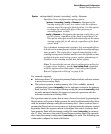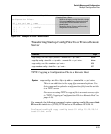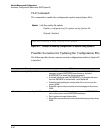
Switch Memory and Configuration
Multiple Configuration Files
Renaming an Existing Startup-Config File
Syntax: rename config < current-filename > < newname-str >
This command changes the name of an existing startup-
config file. A file name can include up to 63, alphanumeric
characters. Blanks are allowed in a file name enclosed in
quotes (“ “ or ‘ ‘). (File names are not case-sensitive.)
Creating a New Startup-Config File
The switch allows up to three startup-config files. You can create a new
startup-config file if there is an empty memory slot or if you want to replace
one startup-config file with another.
Syntax: copy config < source-filename > config < target-filename >
This command makes a local copy of an existing startup-
config file by copying the contents of an existing startup-
config file in one memory slot to a new startup-config file in
another, empty memory slot. This enables you to use a sepa-
rate configuration file to experiment with configuration
changes, while preserving the source file unchanged. It also
simplifies a transition from one software version to another
by enabling you to preserve the startup-config file for the
earlier software version while creating a separate startup-
config file for the later software version. With two such
versions in place, you can easily reboot the switch with the
correct startup-config file for either software version.
• If the destination startup-config file already exists, it is
overwritten by the content of the source startup-config file.
• If the destination startup-config file does not already exist,
it will be created in the first empty configuration memory
slot on the switch.
• If the destination startup-config file does not already exist,
but there are no empty configuration memory slots on the
switch, then a new startup-config file is not created and
instead, the CLI displays the following error message:
Unable to copy configuration to “< target-filename >”.
For example, suppose both primary and secondary flash memory contain
software release “A” and use a startup-config file named config1:
6-31


















